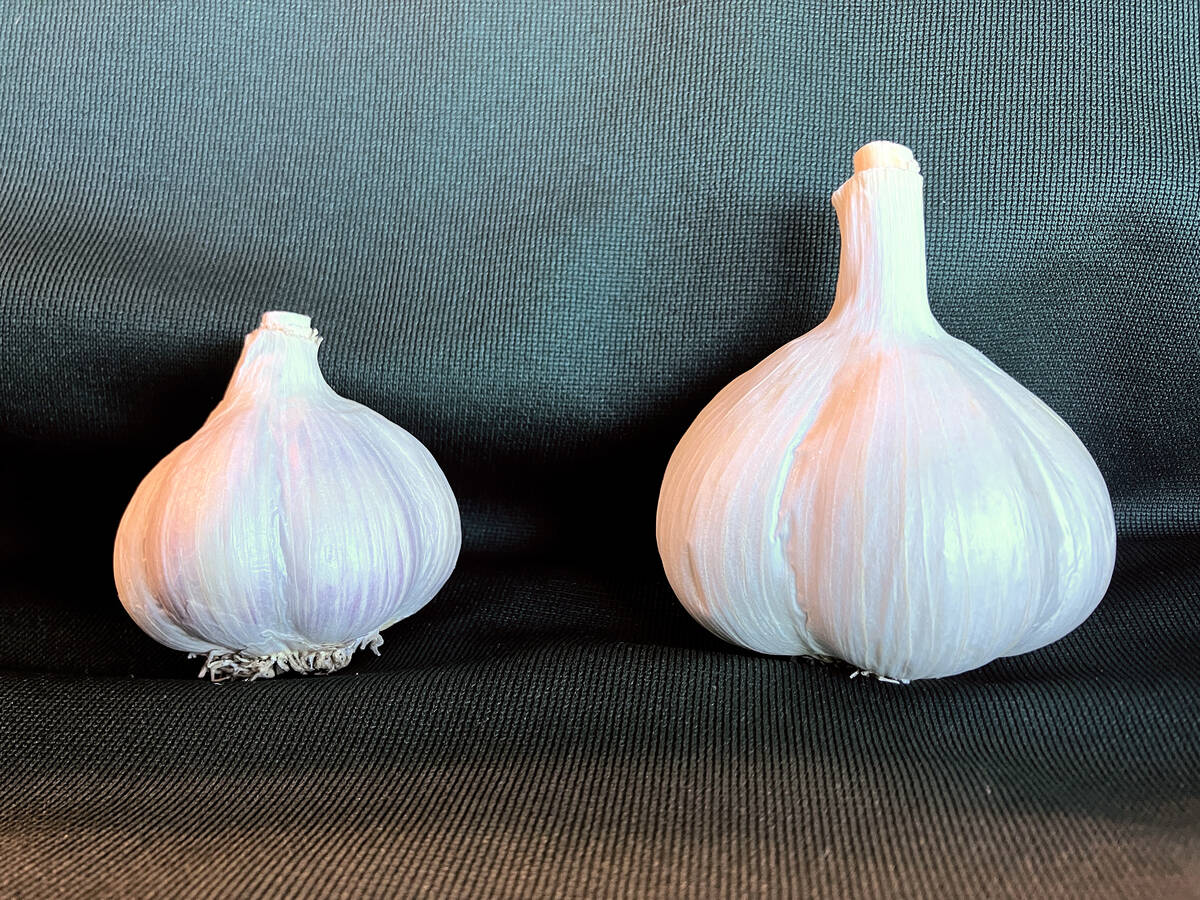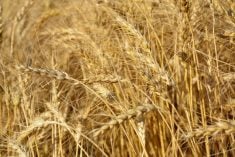Glacier FarmMedia – It’s an essential element for plant growth, but nitrogen in the air all around us has been unavailable to major crops — at least until now. New biological products have arrived in the marketplace that enable crops like wheat, canola, soybean and corn to harvest nitrogen from the air.
Why it matters: Nitrogen costs are increasing and there’s greater focus on the environmental costs of creating it, so alternatives are getting a lot of attention.
First on the scene was a biological product from NexusBioAg called Envita, which is a naturally occurring bacterium called Gluconacetobacter diazotrophicus. Envita was approved for use by the Canadian Food Inspection Agency in June 2020, following six years of farm trials on corn and soybean crops in the United States and Canada. It had its first full-season launch in Canada last year.
Read Also

Clean seed garlic promises bigger bulbs and higher returns for growers
Ontario garlic trials show clean seed outshines conventional yields, with stronger drought resilience, reduced virus risk and greater economic outcomes.
In November 2021, Corteva Agriscience followed suit by introducing Utrisha N, another naturally derived nitrogen-fixing bacterium that Prairie farmers can utilize for the 2022 growing season.
According to Kirsten Ratzlaff, product manager for seed applied technology, fungicides and nutrient management for Corteva Agriscience, Utrisha N was trialed at about 200 sites across Canada last year.
“It’s been quite a rigorous testing process to ensure that nutrition is going to provide the value we intend to provide our Canadian growers,” Ratzlaff says.
“We are really pleased with what we’ve seen performance-wise so far, and we intend to release a full yield summary and trial summary early in the new year.”
Utrisha N is applied as a foliar application. It enters the stomata openings on the epidermis of leaves and other plant material and colonizes the cells within them. The bacteria then quickly begin to capture nitrogen from the air and convert it into a usable form for the plant.
“This capture and convert process continues throughout the life cycle of the plant, resulting in a constant supply of nitrogen throughout the growing season,” says Ratzlaff.
A biostimulant like Utrisha N offers farmers faced with escalating fertilizer prices with another mode of action and a supplemental source of nitrogen, which enables farmers to improve the efficiency of their nutrient management programs. Utrisha N is also a sustainable source of nitrogen, since there are no leaching or loss implications or greenhouse gases released.
“We know that nitrogen fertilizers are a critical component to all farming operations, but they are also subject to loss or may not necessarily be available where or when the plant needs it,” Ratzlaff says. “That’s where Utrisha N comes in — to give that continuous supplemental support and source to ensure the plant has what it needs, when it needs it.”
Utrisha N is designed for established crops across Canada, including soybeans, corn, cereals and canola.
Ratzlaff says as a foliar product, Utrisha N can be applied with spraying equipment found on most farms.
For corn and soybeans, application should be at the V4 to V8 stage. For cereal crops, it is at the four-leaf jointing stage.

Utrisha N is the first in a wave of new biological options for farmers coming from Corteva Agriscience.
“The portfolio is growing, and it is a significant priority for Corteva,” says Ratzlaff. “We’re investing in multiple categories, in biostimulants like Utrisha N, but also in the categories of biocontrol products and pheromones.
“We think this market is going to continue to grow and growers are going to find value for these types of solutions.”
Farm industry receptive
Developed by Azotic North America, Envita was registered in the United States in 2019 and then here in Canada a year later. NexusAgBio is the product’s distributor in Canada.
Daniel Samphir, senior marketing manager at NexusBioAg, says Envita was on display at the company’s BioAdvantage Trials Program, staged in 2021 to demonstrate the product’s effectiveness. A total of 40 farmers from Eastern Canada and 52 farmers from Western Canada and took part.
“We were really excited with our first-year results,” says Samphir, adding there was widespread interest among growers, product dealers, agronomists and the grain industry as a whole.
“This is a tool in the fertility toolbox that we haven’t had until this point,” says Nolan Berg, president of Azotic North America. “Canada has been actually a pleasant surprise in terms of how fast the uptake has been. The entire industry has been very receptive to it.”
Berg says innovative farmers and early adopters are leading the way, but added Envita is also gaining popularity with mainstream growers, noting the high cost of fertilizer and supply chain disruptions could be a factor.
Envita works by forming a symbiotic relationship with the host plant after it enters plant cells. It replicates and spreads throughout the whole plant, providing an alternative source of nitrogen that’s available all season long. By starting to fix nitrogen right away, Envita can also help with early plant establishment.
“It gets into the plant immediately, starts fixing nitrogen immediately and grows with the plant immediately,” says Berg. “We see, basically, a pop-up effect in soybeans and corn and other crops because of the speed of establishment.”
Envita can be applied both in-furrow and in foliar applications, and can be tank mixed with leading starter fertilizers as well as post-emergence herbicides. “We just want to give growers as many options as possible,” he says.
“We talk in terms of Envita filling the nitrogen gap. Imagine there is drought conditions like last year … and the crop only could get to 75 per cent of the nitrogen that it needed. Envita can fill that gap on a corn crop up to 25 per cent,” says Berg. “We actually see even more improved results with Envita under stress conditions.
“What we say to farmers is the first thing to do is to put Envita on with full fertility and see the upside. Prove it to yourself on your crops, on your farm and your conditions.”
Berg says the deepest data sets for Envita have been for corn and soybeans, and the numbers show soybean producers can get up to two to four more bushels per acre and corn producers up to seven to 10 bushels more per acre.
“We’re seeing some great results,” he adds. “When you start talking $5.50 or $6.00 corn and you’re getting seven more bushels, that’s pretty appealing.”
Berg points out Envita also comes with a performance guarantee for canola, wheat, soybeans and corn, as an added incentive for farmers to try it. “We take the risk away (with the guarantee), which essentially boils down to the product paying for itself at current commodity prices,” he says.
Potential game changer
John Heard, a soil fertility extension specialist with Manitoba Agriculture, says products like Envita and Utrisha N could be useful in helping to reduce greenhouse gas emissions from fertilizers used on Canadian farms.
Heard says field trials of the new, nitrogen-fixing biological products have been conducted mostly by industry to date, and he believes more rigorous field validation is required to assess their efficacy in Canadian environments. However, he thinks they have the potential to be a real game changer.
“Until Ag Canada and the universities solidly validate these products, they may not be accepted quickly, but that could be the silver bullet if they work,” Heard says.
Berg says initial work on studying greenhouse gas emissions has shown Envita can reduce emissions by the equivalent of 65 kilograms of carbon dioxide per ton of corn. He believes if producers are regulated to reduce emissions from on-farm use of fertilizers, “products like Envita will become even more important.”
– Mark Halsall is associate editor for Grainews. His article appeared in the Jan. 4, 2022 issue.














